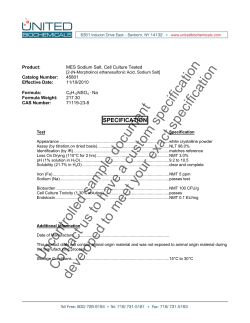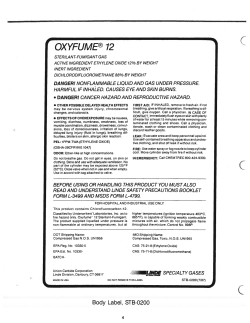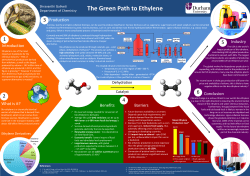
Polysorbate 80
Accessed from 10.6.1.1 by correct6 on Fri May 15 11:37:34 EDT 2015 NF 33 • • • • Official Monographs / Polysorbate 6827 add 5 drops of phenolphthalein TS. Titrate with 0.1 N sodium hydroxide VS. Calculate the acid value as directed in the chapter. Acceptance criteria: NMT 2.0 FATS AND FIXED OILS, Hydroxyl Value 〈401〉: 81–96 FATS AND FIXED OILS, Peroxide Value 〈401〉 Sample: 10.0 g Saturated potassium iodide solution: Prepare a saturated solution of potassium iodide in carbon dioxidefree water. Make sure the solution remains saturated as indicated by the presence of undissolved crystals. Analysis: Introduce the Sample into a 100-mL beaker, and dissolve with 20 mL of glacial acetic acid. Add 1 mL of Saturated potassium iodide solution, mix, and allow to stand for 1 min. Add 50 mL of carbon dioxide-free water and a magnetic stirring bar. Titrate with 0.01 M sodium thiosulfate VS, determining the endpoint potentiometrically (see Titrimetry 〈541〉). Perform a blank titration. Calculate the peroxide value as directed in the chapter. Acceptance criteria: NMT 10.0 FATS AND FIXED OILS, Saponification Value 〈401〉: 45–55 WATER DETERMINATION, Method I 〈921〉: NMT 3.0% ADDITIONAL REQUIREMENTS • PACKAGING AND STORAGE: Preserve in tight containers, protected from light and moisture. Store at room temperature. • LABELING: Label to indicate whether the fatty acids are derived from animal, vegetable, or synthetic sources. • USP REFERENCE STANDARDS 〈11〉 USP Polysorbate 60 RS . Polysorbate 80 Portions of the monograph text that are national USP text, and are not part of the harmonized text, are marked with symbols (◆◆) to specify this fact. Sorbitan, mono-9-octadecenoate, poly(oxy-1,2-ethanediyl) derivs., (Z)-; Polyoxyethylene 20 sorbitan monooleate [9005-65-6]. Sample solution: Dissolve 0.10 g of Polysorbate 80 in 2 mL of Diluent in a 25-mL conical flask, and boil under a reflux condenser for 30 min. Add 2.0 mL of 14% boron trifluoride–methanol through the condenser, and boil for 30 min. Add 4 mL of heptane through the condenser, and boil for 5 min. Cool, and add 10.0 mL of Saturated sodium chloride solution, shake for about 15 s, and add a quantity of Saturated sodium chloride solution such that the upper phase is brought into the neck of the flask. Collect 2 mL of the upper phase, wash with three quantities, each of 2 mL, of water, and dry over anhydrous sodium sulfate. Table 1 Mixture of the Following Substances Methyl myristate Methyl palmitate Methyl stearate Methyl arachidate Methyl oleate Methyl eicosenoate Methyl behenate Methyl lignocerate Composition (%) 5 10 15 20 20 10 10 10 Chromatographic system (See Chromatography 〈621〉, System Suitability.) Mode: GC Detector: Flame ionization Column: 0.32-mm × 30-m G16 on fused silica, film thickness 0.5 µm Temperatures Injection port: 250° Detector: 250° Column: See Table 2. Table 2 . DEFINITION Polysorbate 80 is a mixture of partial esters of fatty acids, mainly oleic acid, with sorbitol and its anhydrides ethoxylated with approximately 20 moles of ethylene oxide for each mole of sorbitol and sorbitol anhydrides. ASSAY • COMPOSITION OF FATTY ACIDS Diluent: 20 g/L of sodium hydroxide in methanol Saturated sodium chloride solution: Sodium chloride and water (1:2). Before use, decant the solution from any undissolved substance and filter, if necessary. Reference solution A: Prepare 0.50 g of the mixture of calibrating substances with the composition described in Table 1. Dissolve in heptane, and dilute with heptane to 50.0 mL. Reference solution B: Reference solution A in heptane (1 in 10) Reference solution C: Prepare 0.50 g of a mixture of fatty acid methyl esters, which corresponds to the composition of the substance to be examined. Dissolve in heptane, and dilute with heptane to 50.0 mL. [NOTE— Commercially available mixtures of fatty acid methyl esters may also be used.] Temperature Ramp (°/min) 10 — Final Temperature (°) 220 220 Hold Time at Final Temperature (min) — 40 Carrier gas: Helium Linear velocity: 50 cm/s Injection volume: 1 µL System suitability Samples: Reference solution A and Reference solution B Suitability requirements Resolution: NLT 1.8 between the peaks due to methyl oleate and methyl stearate, Reference solution A Signal-to-noise ratio: NLT 5 for the peak of methyl myristate, Reference solution B Theoretical plates: NLT 30,000 calculated for the peak of methyl stearate, Reference solution A Analysis Sample: Sample solution Identify the peaks from Reference solution C. Calculate the percentage of each component in the Sample solution: Result = (AC/AT) × 100 AC = peak area for the component of interest AT = total area of all peaks related to fatty acids Acceptance criteria: See Table 3. Official from May 1, 2015 Copyright (c) 2015 The United States Pharmacopeial Convention. All rights reserved. NF Monographs IDENTIFICATION • A. It meets the requirements of the test for Composition of Fatty Acids. • B. INFRARED ABSORPTION 〈197F〉 Initial Temperature (°) 80 220 Accessed from 10.6.1.1 by correct6 on Fri May 15 11:37:34 EDT 2015 6828 Polysorbate / Official Monographs NF 33 Temperatures Injection port: 85° Detector: 250° Column: See Table 4. Table 3 Name Myristic acid Palmitic acid Palmitoleic acid Stearic acid Oleic acid Linoleic acid Linolenic acid Acceptance Criteria, NMT (%) 5.0 16.0 8.0 6.0 — 18.0 4.0 Acceptance Criteria, NLT (%) — — — — 58.0 — — Table 4 Initial Temperature (°) 70 250 CEO = concentration of ethylene oxide in Sample solution B (µg/mL) AA = peak area of ethylene oxide from Sample solution A AB = peak area of ethylene oxide from Sample solution B Calculate the content of dioxane: •• ◆HEAVY METALS, Method II 〈231〉: NMT 10 ppm◆• (Official . NF Monographs 1-Dec-2015) . 1 . Hold Time at Final Temperature (min) — 5 Result = (2 × CEO × AA)/(AB − AA) Delete the following: • ETHYLENE OXIDE AND DIOXANE Ethylene oxide standard solution: Dilute 0.5 mL of a commercially available solution of ethylene oxide in methylene chloride (50 mg/mL) with water to 50.0 mL. [NOTE—The solution is stable for 3 months, if stored in vials with a Teflon-coated, silicon membrane and crimped caps at −20°.] Allow to reach room temperature. Dilute 1.0 mL of this solution with water to 250.0 mL. Dioxane standard solution: Dioxane in water (v/v) 1 in 20,000 Acetaldehyde standard solution: 0.01 mg/mL of acetaldehyde in water Standard solution: Dilute 6.0 mL of Ethylene oxide standard solution and 2.5 mL of Dioxane standard solution with water to 25.0 mL. Sample solution A: Transfer 1.0 g of Polysorbate 80 to a 10-mL headspace vial. Add 2.0 mL of water, and seal the vial immediately with a Teflon-coated, silicon membrane and an aluminum cap. Sample solution B: Transfer 1.0 g of Polysorbate 80 to a 10-mL headspace vial. Add 2.0 mL of Standard solution, and seal the vial immediately with a Teflon-coated, silicon membrane and an aluminum cap. Reference solution: Introduce 2.0 mL of Acetaldehyde standard solution and 2.0 mL of Ethylene oxide standard solution to a 10-mL headspace vial, and seal the vial immediately with a Teflon-coated, silicon membrane and an aluminum cap. Chromatographic system (See Chromatography 〈621〉, System Suitability.) Mode: Headspace GC Detector: Flame ionization Column:1 0.53-mm × 50-m G27 on fused silica, film thickness 5 µm Final Temperature (°) 250 250 Split ratio: 3.5: 1 Carrier gas: Helium Flow rate: 4.0 mL/min Injection volume: 1 mL System suitability Sample: Reference solution [NOTE—The relative retention times for ethylene oxide, acetaldehyde, and dioxane are 1.0, 0.9, and 1.9, respectively. The retention time for ethylene oxide is about 6.5 min.] Suitability requirements Resolution: NLT 2.0 between the peaks due to acetaldehyde and ethylene oxide Analysis Samples: Sample solution A and Sample solution B Calculate the content of ethylene oxide: IMPURITIES • RESIDUE ON IGNITION Sample: 2.00 g Analysis: Heat a silica or platinum crucible to redness for 30 min, allow to cool in a desiccator, and weigh. Evenly distribute the Sample in the crucible. Dry at 100°–105° for 1 h and ignite to constant mass in a muffle furnace at 600 ± 25°, allowing the crucible to cool in a desiccator after each ignition. Flames should not be produced at any time during the procedure. If after prolonged ignition the ash still contains black particles, take up with hot water, pass through an ashless filter paper, and ignite the residue and the filter paper. Combine the filtrate with the ash, carefully evaporate to dryness, and ignite to constant mass. Acceptance criteria: NMT 0.25% . Temperature Ramp (°/min) 10 — Result = (2 × D × CD × AA′)/(AB′ − AA′) D CD = density of dioxane, 1.03 g/mL = concentration of dioxane in Sample solution B (µL/mL) = peak area of dioxane from Sample solution A AA′ = peak area of dioxane from Sample solution B AB′ Acceptance criteria: NMT 1 ppm for ethylene oxide; NMT 10 ppm for dioxane SPECIFIC TESTS • ◆SPECIFIC GRAVITY 〈841〉: 1.06–1.09◆ . Change to read: • •VISCOSITY—CAPILLARY METHODS 〈911〉 or VISCOSITY—ROTATIONAL METHODS 〈912〉• (CN 1-May-2015): 300–500 centis- ◆ . . tokes at 25°◆ • FATS AND FIXED OILS, Acid Value 〈401〉 Sample solution: Dissolve 5.0 g in 50 mL of a mixture of equal volumes of alcohol and hexane (previously neutralized with 0.1 N potassium hydroxide or 0.1 N sodium hydroxide), using 0.5 mL of phenolphthalein TS as indicator. If necessary, heat to about 90° to dissolve the substance to be examined. Analysis: Titrate the Sample solution with 0.1 N potassium hydroxide or 0.1 N sodium hydroxide until the pink color persists for at least 15 s. When heating has been applied to aid dissolution, maintain the temperature at about 90° during the titration. CP-Sil 8 CB is suitable. Official from May 1, 2015 Copyright (c) 2015 The United States Pharmacopeial Convention. All rights reserved. Accessed from 10.6.1.1 by correct6 on Fri May 15 11:37:34 EDT 2015 NF 33 Official Monographs / Polyvinyl 6829 Acceptance criteria: NMT 2.0 • FATS AND FIXED OILS, Hydroxyl Value 〈401〉 Sample: 2.0 g Analysis: Introduce the Sample into a 150-mL acetylation flask fitted with an air condenser. Add 5.0 mL of Pyridine–Acetic Anhydride Reagent, and attach the air condenser. Heat the flask in a water bath for 1 h keeping the level of the water about 2.5 cm above the level of the liquid in the flask. Withdraw the flask, and allow to cool. Add 5 mL of water through the upper end of the condenser. If a cloudiness appears, add sufficient pyridine to clear it, noting the volume added. Shake the flask, and replace in the water bath for 10 min. Withdraw the flask, and allow to cool. Rinse the condenser and the walls of the flask with 5 mL of alcohol, previously neutralized with phenolphthalein TS. Titrate with 0.5 N alcoholic potassium hydroxide VS using 0.2 mL of phenolphthalein TS as indicator. Carry out a blank test under the same conditions. Acceptance criteria: 65–80 • FATS AND FIXED OILS, Peroxide Value 〈401〉 Sample: 10.0 g Saturated potassium iodide solution: Prepare a saturated solution of potassium iodide in carbon dioxidefree water. Make sure the solution remains saturated as indicated by the presence of undissolved crystals. Analysis: Introduce the Sample into a 100-mL beaker, and dissolve with 20 mL of glacial acetic acid. Add 1 mL of Saturated potassium iodide solution, and allow to stand for 1 min. Add 50 mL of carbon dioxide-free water and a magnetic stirring bar. Titrate with 0.01 M sodium thiosulfate VS, determining the endpoint potentiometrically. Carry out a blank titration. Acceptance criteria: NMT 10 • FATS AND FIXED OILS, Saponification Value 〈401〉 Sample: 4.0 g Analysis: Introduce the Sample into a 250-mL borosilicate glass flask fitted with a reflux condenser. Add 30.0 mL of 0.5 N alcoholic potassium hydroxide VS and a few glass beads. Attach the condenser, and heat under reflux for 60 min. Add 1 mL of phenolphthalein TS and 50 mL of dehydrated alcohol, and titrate immediately with 0.5 N hydrochloric acid VS. Carry out a blank test under the same conditions. Acceptance criteria: 45–55 • WATER DETERMINATION, Method I 〈921〉: NMT 3.0%, determined on 1.0 g . . Polyvinyl Acetate (C4H6O2)n Vinyl acetate homopolymer Vinyl acetate resin [9003-20-7]. DEFINITION Polyvinyl acetate is a thermoplastic polymer, represented by the formula: IDENTIFICATION • A. PROCEDURE Sample: 100 mg of Polyvinyl Acetate Analysis: Dissolve the Sample in 2.5 mL of acetone, place two drops on a potassium bromide plate, and dry to evaporate the solvent. Acceptance criteria: The IR absorption spectrum of polyvinyl acetate exhibits maxima corresponding to the same wavelengths as that of a similar preparation of USP Polyvinyl Acetate RS, treated in the same manner. • B. PROCEDURE Sample: 0.5 g of Polyvinyl Acetate Analysis: Saponify the Sample in a mixture of 25.0 mL of 0.5 N alcoholic potassium hydroxide and 25.0 mL of water. Acceptance criteria: The solution so obtained meets the requirements of the tests for Identification Tests— General 〈191〉, Acetate. IMPURITIES Inorganic Impurities • RESIDUE ON IGNITION 〈281〉: NMT 0.1% Delete the following: •• HEAVY METALS, Method II 〈231〉: NMT 10 ppm• (Official 1. Dec-2015) • RESIDUAL PEROXIDES Sample: 0.85 g of Polyvinyl Acetate Analysis: Place the Sample in a borosilicate glass flask with a ground-glass neck. Add 10.0 mL of ethyl acetate, and heat under a reflux condenser with constant agitation. Allow to cool. Replace the air in the container with oxygen-free nitrogen, and add a solution of 1.0 mL of glacial acetic acid and 0.5 g of sodium iodide in 40.0 mL of water. Shake thoroughly, and allow to stand protected from light for 20 min. Titrate with 0.005 N sodium thiosulfate VS until the yellow color is discharged. Perform a blank titration. Acceptance criteria: The difference between the titration volumes is not greater than 1.0 mL; and NMT 100 ppm, calculated as hydrogen peroxide, is found. Organic Impurities • PROCEDURE: LIMIT OF VINYL ACETATE Standard stock solution: 1.0 mg/mL of Vinyl Acetate in toluene Standard solutions: 0.1, 0.3, 1, 3, and 10 µg/mL of vinyl acetate in toluene, prepared from Standard stock solution Sample solution: 0.1 g/mL of Polyvinyl Acetate in toluene Chromatographic system (See Chromatography 〈621〉, System Suitability.) Mode: GC Detector: Hydrogen flame ionization Column: 0.32-mm × 30-m fused-silica capillary column, 5-µm layer of phase G1 Temperature Detector: 250° Injector port: 150° Column: See the temperature program table below. Initial Temperature (°) 100 100 Temperature Ramp (°/min) — 20 Final Temperature (°) 100 250 (C4H6O2)n Official from May 1, 2015 Copyright (c) 2015 The United States Pharmacopeial Convention. All rights reserved. Hold Time at Final Temperature (min) 8 5 NF Monographs ADDITIONAL REQUIREMENTS • PACKAGING AND STORAGE: Store in an airtight container, protected from light. • ◆USP REFERENCE STANDARDS 〈11〉 USP Polysorbate 80 RS◆ in which the value of n lies between approximately 100 and 17,000.
© Copyright 2025









